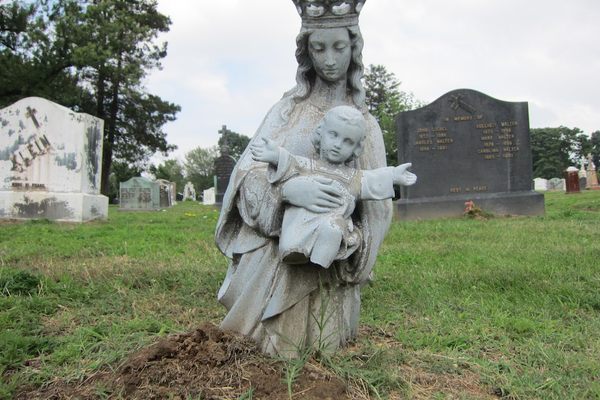Washington Irving Bishop: The Magician Killed by an Autopsy
Detail of a 1523 anatomical illustration by Jacopo Berengario da Carpi (via Wikimedia)
In Brooklyn’s Green-Wood Cemetery, on a well-worn headstone, you can barely make out the inscription “The Martyr” above the name Washington Irving Bishop. The rest of the long epitaph below is too deteriorated to read, but the late Bishop was renowned in his time as one of the great mentalists of the 19th century. Yet it was his curious death that would be his greatest mystery.
Washington Irving Bishop’s grave in Green-Wood Cemetery (photograph by the author)
Bishop was born in 1855 and although the American started out in the spiritualist world — assisting and then managing the famed medium Anna Eva Fay — he later flipped to the side of contemporary magicians like Houdini in exposing spiritualism as superstition. In 1880 he published a one shilling book called Second Sight Explained, in which he wrote:
“There is, indeed, much reason in favour of an explanation of Clairvoyance, because knowledge of the process is still sufficiently obscure to enable unprincipled persons to use the influence that this supposed power gives them for improper purposes. Nothing can be more detrimental to morals than the prevalence of superstition; and there is scarcely a phenomenon in existence which operates so largely to the encouragement of superstition as the supposed power of Clairvoyance.”
His own act was pitched as “thought reading,” and he emphasized that it was not anything supernatural but instead his careful reading of the movement of the human body. Known as “muscle reading,” he learned his skills from mentalist J. Randall Brown and soon soared to his own fame with a distinctly frenetic performance style, one that had an added drama with his suffering from cataleptic fits. He kept a note in his pocket that stated his seemingly catatonic state was not death, although the presence of that note on a fateful performance in 1889 would lead to a great debate of what really brought down the mentalist.
Washington Irving Bishop (via the University of Texas)
It was May 12 and Bishop was at the Lambs Club, a theatrical society that was then at 70 West 36th Street in Manhattan. Bishop was said to have fallen into unconsciousness early in the act, and then recovered to continue. However, a second attack came from which he did not quickly recover. According to reports, an autopsy took place at 3:45 pm, just a few hours after the supposed death. This included the removing of Bishop’s brain.
As Dean Carnegie wrote in his research on the strange case for his blog the Magic Detective, when Bishop’s wife finally arrived on the scene and saw the slice across his skull, she declared, “they’ve killed my husband!” A second autopsy was later performed on May 28 in which the brain was found sewn into his chest, and “all seemed healthy, and in appearance presented no cause for death,” although curiously “portions of the brain and other organs were missing.”
Whether or not that note warning potential physicians of Bishop’s condition was on his body, and why the brain was so quickly removed, were the subject of debate and litigation for years to come. The leader of this crusade was Bishop’s mother Eleanor Fletcher Bishop, who spent the next nearly three decades of her life bringing charges against the doctors who performed the autopsy and touring the country with her story. She even published a book dramatically named: A Mother’s Life Dedicated and an Appeal for Justice to All Brother Masons and the Generous Public — A Synopsis of the Butchery of the Late Sir Washington Irving Bishop (Kamilimilianalani) A Most Worthy Mason of the Thirty-Second Degree, the Mind Reader, and Philanthropist By Eleanor Fletcher Bishop, His Broken-Hearted Mother. It included a photograph of her leaning over her son’s glass-topped coffin on the frontispiece, the macabre scar of the autopsy visible on his forehead.
Irving in his coffin, viewed by his mother (via the University of Texas)
It’s not clear if the Masons ever came to her aid, although the mason Harry Houdini helped her out later in life by buying what remained of Bishop’s legacy. The death certificate for the 33-year-old mentalist officially read “hysterocatalepsy”; to his mother it was always murder. And while Bishop’s legacy in the history of magic may have faded, there remains that worn tombstone in Green-Wood Cemetery that declares him as a “martyr” for eternity, or at least until the marble wears beyond recognition.
“The Martyr”: Washington Irving Bishop’s epitaph in Green-Wood Cemetery (photograph by the author)
Thanks to Dead Conjurers, a site dedicated to magician graves, for its post that helped the author to locate the final resting place of Washington Irving Bishop.
Morbid Mondays highlight macabre stories from around the world and through time, indulging in our morbid curiosity for stories from history’s darkest corners. Read more Morbid Mondays>


















Follow us on Twitter to get the latest on the world's hidden wonders.
Like us on Facebook to get the latest on the world's hidden wonders.
Follow us on Twitter Like us on Facebook